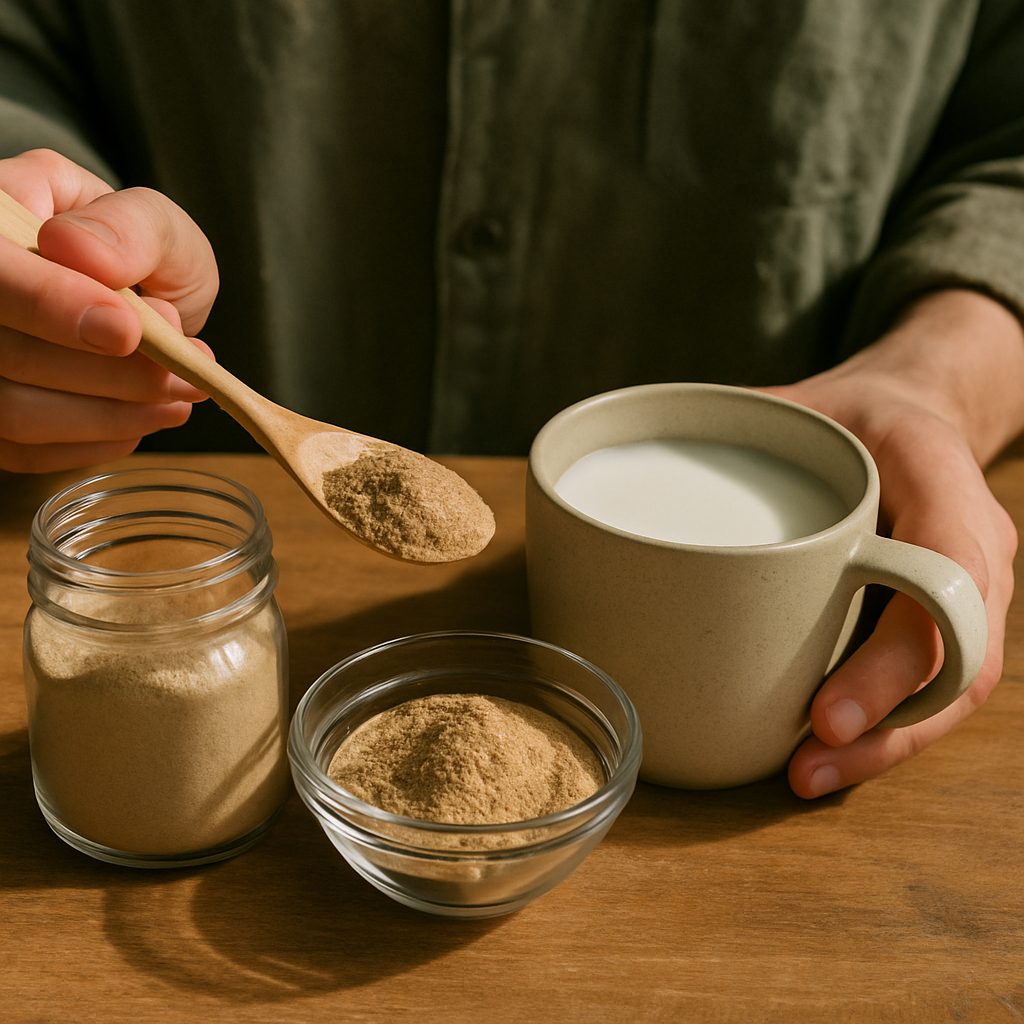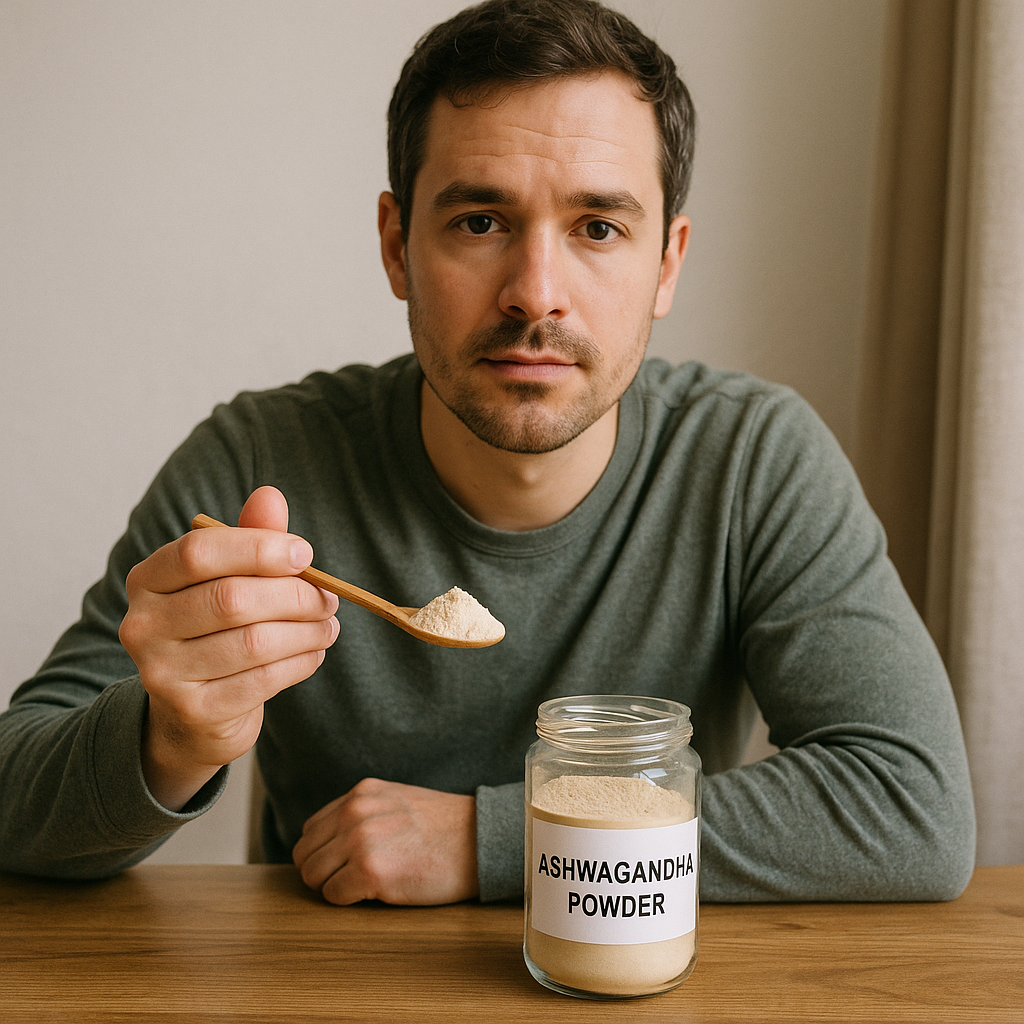आयुर्वेदिक डॉक्टर से प्रश्न पूछें और निःशुल्क या भुगतान मोड में अपनी चिंता की समस्या पर ऑनलाइन परामर्श प्राप्त करें। 2,000 से अधिक अनुभवी डॉक्टर हमारी साइट पर काम करते हैं और आपके प्रश्नों का इंतजार करते हैं और उपयोगकर्ताओं को उनकी स्वास्थ्य समस्याओं को हल करने में प्रतिदिन मदद करते हैं।
अभी हमारे स्टोर में खरीदें
अश्वगंधा पाउडर का उपयोग कैसे करें: आयुर्वेदिक गाइड और फायदे

अगर आपने कभी सोचा है अश्वगंधा पाउडर का उपयोग कैसे करें या अश्वगंधा पाउडर कैसे लें एक सुरक्षित और प्रभावी तरीके से, तो आप अकेले नहीं हैं। यह प्राचीन आयुर्वेदिक जड़ी-बूटी दुनिया भर में बहुत लोकप्रिय हो गई है, और अच्छे कारण से—यह तनाव को कम करने में मदद करती है, ऊर्जा बढ़ाती है, और यहां तक कि नींद की गुणवत्ता में सुधार कर सकती है। लेकिन कई लोग सही अश्वगंधा पाउडर के उपयोग या उचित अश्वगंधा पाउडर के लाभ के बारे में भ्रमित हो जाते हैं। क्या इसे पानी के साथ मिलाना चाहिए? या शायद दूध के साथ? कितना ज्यादा है? यह गाइड इसे एक सरल, व्यावहारिक तरीके से समझाएगा ताकि आप इसे अपनी दैनिक दिनचर्या में आत्मविश्वास के साथ शामिल कर सकें।
अश्वगंधा पाउडर क्या है और इसका आयुर्वेदिक महत्व
अश्वगंधा (Withania somnifera) को अक्सर "भारतीय जिनसेंग" कहा जाता है, हालांकि यह तकनीकी रूप से जिनसेंग से संबंधित नहीं है। आयुर्वेद में, इसे रसायन के रूप में वर्गीकृत किया गया है, जिसका अर्थ है कि यह एक पुनर्योजी जड़ी-बूटी है जो दीर्घायु, ऊर्जा और जीवन शक्ति को बढ़ावा देने के लिए डिज़ाइन की गई है। सदियों से, भारत में चिकित्सकों ने इसे शरीर की तनाव प्रतिक्रिया को संतुलित करने और प्रतिरक्षा प्रणाली को मजबूत करने के लिए उपयोग किया है।
पाउडर आमतौर पर पौधे की जड़ से बनाया जाता है, जिसे सुखाकर पीला-पीला महीन पाउडर बनाया जाता है। इसके थोड़े कड़वे, मिट्टी के स्वाद के कारण, कई लोग इसे दूध, शहद या स्मूदी के साथ मिलाना पसंद करते हैं बजाय इसे सादा खाने के।
स्वास्थ्य के लिए अश्वगंधा पाउडर के लाभ
अश्वगंधा पाउडर के अनगिनत लाभ हैं जो आधुनिक विज्ञान द्वारा समर्थित हैं:
-
तनाव और चिंता से राहत: अश्वगंधा को एक एडाप्टोजेन माना जाता है, जिसका अर्थ है कि यह शरीर को तनाव के अनुकूल बनाने में मदद करता है।
-
बेहतर नींद: कई उपयोगकर्ता नियमित उपयोग के कुछ हफ्तों बाद गहरी, अधिक आरामदायक नींद का अनुभव करते हैं।
-
ऊर्जा और ध्यान: यह थकान को कम कर सकता है और हल्के ब्रेन फॉग में भी मदद कर सकता है।
-
हार्मोनल संतुलन: परंपरागत रूप से, इसे पुरुषों और महिलाओं दोनों के लिए प्रजनन स्वास्थ्य का समर्थन करने के लिए उपयोग किया गया है।
-
प्रतिरक्षा: शरीर की प्राकृतिक रक्षा प्रणाली को बढ़ाता है—जो इन दिनों हम सभी को अधिक चाहिए।
बेशक, परिणाम भिन्न होते हैं, और जबकि कुछ लोग जल्दी लाभ महसूस करते हैं, दूसरों के लिए बदलाव देखने में लगातार उपयोग की आवश्यकता होती है।
अश्वगंधा पाउडर के पारंपरिक उपयोग
ऐतिहासिक रूप से, अश्वगंधा को रात में गर्म दूध में मिलाकर मन को शांत करने और अच्छी नींद को प्रोत्साहित करने के लिए लिया जाता था। दूसरी ओर, योद्धा कभी-कभी इसे युद्धों से पहले ताकत और सहनशक्ति बढ़ाने के लिए लेते थे। आज, आधुनिक जीवनशैली अधिक रचनात्मक अश्वगंधा पाउडर के उपयोग की अनुमति देती है—लट्टे से लेकर प्रोटीन शेक तक।

दैनिक जीवन में अश्वगंधा पाउडर का उपयोग कैसे करें
अब बड़ा सवाल: अश्वगंधा पाउडर को कैसे खाएं ताकि यह प्रभावी और आनंददायक हो? यह वास्तव में बहुत बहुमुखी है। आप इसे गर्म तरल पदार्थों में मिला सकते हैं, भोजन के साथ मिला सकते हैं, या अगर आप जल्दी में हैं तो इसे पानी के साथ भी ले सकते हैं।
अश्वगंधा पाउडर को सुरक्षित रूप से कैसे लें
अगर आप नए हैं, तो छोटे से शुरू करें। आधा चम्मच से शुरू करें और धीरे-धीरे बढ़ाएं जैसे आपका शरीर अनुकूल होता है। अगर आप गर्भवती हैं, स्तनपान कर रही हैं, या दवा पर हैं, तो हमेशा एक स्वास्थ्य सेवा प्रदाता से जांचें। निरंतरता महत्वपूर्ण है, लेकिन सुरक्षा भी। बहुत अधिक लेने से पेट खराब हो सकता है या नींद आ सकती है।
अश्वगंधा पाउडर को पानी के साथ कैसे लें
यह सबसे सरल तरीका है। लगभग आधा चम्मच गुनगुने पानी में मिलाएं और इसे दिन में एक या दो बार पिएं। यह त्वरित है, लेकिन हर किसी को इसका कड़वा स्वाद पसंद नहीं आता। एक टिप? इसे अधिक स्वादिष्ट बनाने के लिए नींबू का रस या थोड़ा शहद मिलाएं।
अश्वगंधा पाउडर को दूध के साथ कैसे उपयोग करें
यह शायद सबसे क्लासिक तरीका है और आयुर्वेद में अभी भी व्यापक रूप से अनुशंसित है। एक चम्मच को एक कप गर्म दूध (डेयरी या प्लांट-बेस्ड) में मिलाएं, शायद अतिरिक्त स्वाद के लिए एक चुटकी दालचीनी या इलायची के साथ। सोने से पहले लिया गया, यह एक सुखदायक नींद टॉनिक के रूप में दोगुना हो जाता है।

अश्वगंधा पाउडर की खुराक और समय
लोगों द्वारा पूछे जाने वाले सबसे सामान्य प्रश्नों में से एक है: अश्वगंधा पाउडर की सही खुराक क्या है? इसका उत्तर एक-आकार-फिट-सभी नहीं है। खुराक आपकी उम्र, स्वास्थ्य स्थिति और समग्र लक्ष्यों पर निर्भर करती है। आयुर्वेद आमतौर पर संयम पर जोर देता है—बहुत कम परिणाम नहीं दे सकता, जबकि बहुत अधिक असुविधा का कारण बन सकता है।
वयस्कों के लिए अनुशंसित अश्वगंधा पाउडर की खुराक
अधिकांश स्वस्थ वयस्कों के लिए, एक सामान्य अश्वगंधा पाउडर की खुराक 1 से 2 चम्मच दैनिक (लगभग 3-6 ग्राम) होती है। शुरुआती लोग यह देखने के लिए सिर्फ आधा चम्मच से शुरू कर सकते हैं कि उनका शरीर कैसे प्रतिक्रिया करता है। कुछ लोग इसे दो छोटे खुराकों में विभाजित करते हैं—सुबह और शाम—जबकि अन्य इसे एक बार में लेना पसंद करते हैं, आमतौर पर रात में।
लेकिन याद रखें: इस तरह की जड़ी-बूटियाँ सबसे अच्छा काम करती हैं जब नियमित रूप से समय के साथ ली जाती हैं, न कि एक त्वरित समाधान के रूप में। बड़े बदलाव देखने के लिए हफ्तों या यहां तक कि कुछ महीनों तक सोचें।
परिणामों के लिए अश्वगंधा पाउडर लेने का सबसे अच्छा समय
जब अश्वगंधा पाउडर को प्रभावी ढंग से लेने की बात आती है, तो समय महत्वपूर्ण होता है।
-
सुबह: ऊर्जा, ध्यान और दिन के समय तनाव को कम करने के लिए अच्छा है। इसे स्मूदी या चाय में आज़माएं।
-
शाम: नींद, विश्राम और सोने से पहले कोर्टिसोल स्तर को संतुलित करने के लिए उत्कृष्ट।
-
भोजन के साथ: पाचन में मदद करता है और संवेदनशील लोगों के लिए पेट की जलन को कम कर सकता है।
कोई एकल "सही" समय नहीं है, लेकिन निरंतरता घड़ी से अधिक महत्वपूर्ण है। एक ऐसी दिनचर्या चुनें जिसे आप वास्तव में पालन कर सकें (अन्यथा यह आपकी रसोई कैबिनेट में भूल जाने वाला एक और पूरक बन जाता है)।
अश्वगंधा पाउडर को खाने या पीने के व्यावहारिक तरीके
अगर आपको सादा पाउडर पसंद नहीं है, तो चिंता न करें। ऐसे रचनात्मक और स्वादिष्ट अश्वगंधा पाउडर के उपयोग हैं जो इसे दैनिक जीवन में फिट करना आसान बनाते हैं।
भोजन के साथ अश्वगंधा पाउडर कैसे खाएं
भोजन में अश्वगंधा जोड़ना सरल है। इसे सूप, करी, या यहां तक कि दलिया में थोड़ी मात्रा में छिड़कें। इसका मिट्टी का स्वाद ठंडे खाद्य पदार्थों की तुलना में गर्म, मसालेदार व्यंजनों के साथ बेहतर मिश्रित होता है। एक और ट्रिक? इसे शहद के साथ मिलाकर पेस्ट बनाएं और टोस्ट पर फैलाएं या सीधे एक चम्मच खाएं (हालांकि स्वाद मजबूत है)।
कुछ लोग इसे खजूर और नट्स के साथ ऊर्जा बॉल्स में भी मिलाते हैं, जो कड़वाहट को छुपाता है और इसे एक स्वादिष्ट स्नैक में बदल देता है।
अश्वगंधा पाउडर का उपयोग करने के लिए रेसिपी और तैयारी
यहां कुछ लोकप्रिय विचार हैं अगर आप सोच रहे हैं अश्वगंधा पाउडर को अधिक आनंददायक तरीकों से कैसे खाएं:
-
अश्वगंधा लट्टे: पाउडर को गर्म दूध (डेयरी या प्लांट-बेस्ड) के साथ मिलाएं, शहद, दालचीनी, और एक चुटकी जायफल डालें। सोने से पहले के लिए बढ़िया।
-
स्मूदी बूस्ट: आधा चम्मच एक केले की स्मूदी में बादाम के दूध और मूंगफली के मक्खन के साथ मिलाएं। यह मिट्टी के स्वाद को अच्छी तरह से छुपाता है।
-
गोल्डन अश्वगंधा चाय: अश्वगंधा को हल्दी, अदरक, और काली मिर्च के साथ गर्म पानी में मिलाएं। अगर आपको मीठा पसंद है तो शहद डालें।
-
प्रोटीन बॉल्स: ओट्स, नट बटर, शहद, और अश्वगंधा पाउडर मिलाएं। छोटे बॉल्स में रोल करें और रेफ्रिजरेट करें। चलते-फिरते स्नैक के रूप में परफेक्ट।
ये रेसिपी न केवल अश्वगंधा पाउडर को कैसे खाएं को आसान बनाती हैं, बल्कि यह भी सुनिश्चित करती हैं कि आप इसे रोजाना लेने का आनंद लेंगे बजाय इसके स्वाद से डरने के।
निरंतरता और वास्तविक अपेक्षाओं पर एक नोट
यह फिर से उल्लेख करने लायक है: अश्वगंधा जैसी जड़ी-बूटियाँ जादुई गोलियाँ नहीं हैं। पहले चम्मच के बाद आप तुरंत शांत महसूस नहीं करेंगे। लाभ आमतौर पर धीरे-धीरे बनते हैं जैसे आपका शरीर अनुकूल होता है। कुछ लोग 1-2 हफ्तों के बाद अधिक आराम महसूस करते हैं, जबकि अन्य एक या दो महीने के बाद बदलाव देखते हैं।
अगर आप वेलनेस के प्रति गंभीर हैं, तो इसे अन्य स्वस्थ जीवनशैली की आदतों के साथ मिलाएं—जैसे बेहतर नींद की दिनचर्या, सचेत भोजन, या व्यायाम। अन्यथा, आप सिर्फ एक जड़ी-बूटी से बहुत अधिक उम्मीद कर सकते हैं।
निष्कर्ष
अब आप जानते हैं अश्वगंधा पाउडर का उपयोग कैसे करें विभिन्न तरीकों से—चाहे पानी के साथ मिलाकर, गर्म दूध में मिलाकर, या स्मूदी और भोजन में जोड़कर। आपने अश्वगंधा पाउडर के कई लाभ भी देखे हैं, तनाव को कम करने और नींद का समर्थन करने से लेकर दिन के दौरान ऊर्जा और ध्यान बढ़ाने तक।
वास्तविक जादू, हालांकि, एकल सेवा से नहीं बल्कि निरंतरता से आता है। इसे रोजाना एक सुरक्षित अश्वगंधा पाउडर की खुराक में लेना जो आपके शरीर के लिए काम करता है, वही दीर्घकालिक परिणाम लाता है। कुछ लोग पानी की सादगी पसंद करते हैं, जबकि अन्य सोने से पहले गर्म दूध की आरामदायक परंपरा का आनंद लेते हैं। आप जो भी चुनें, कुंजी इसे आनंददायक बनाना है ताकि यह वास्तव में आपकी दिनचर्या का हिस्सा बन जाए—सिर्फ एक और "सुपरफूड" नहीं जो शेल्फ पर धूल जमा कर रहा हो।
अश्वगंधा शक्तिशाली है, हाँ, लेकिन यह एक व्यापक स्वस्थ जीवनशैली का हिस्सा बनने पर सबसे अच्छा काम करता है। इसे अच्छी नींद, संतुलित भोजन, और तनाव कम करने वाली आदतों के साथ जोड़ें। फिर, जो आपने सीखा है उसे दोस्तों या परिवार के साथ साझा करें—क्योंकि वेलनेस हमेशा साझा करने पर बेहतर होता है।
अक्सर पूछे जाने वाले प्रश्न
अश्वगंधा पाउडर लेने का सबसे अच्छा समय क्या है?
सबसे अच्छा समय आपके लक्ष्यों पर निर्भर करता है। अगर आप अधिक ऊर्जा और ध्यान चाहते हैं, तो सुबह एक अच्छा विकल्प है। अगर आपका मुख्य लक्ष्य बेहतर नींद या विश्राम है, तो इसे शाम को, विशेष रूप से गर्म दूध में लेने की कोशिश करें। ईमानदारी से, कोई सख्त नियम नहीं है—बस उस समय के साथ निरंतर रहें जो आपके लिए काम करता है।
अश्वगंधा पाउडर को किसके साथ मिलाएं?
क्लासिक विकल्पों में पानी, दूध, या शहद शामिल हैं। एक अधिक आधुनिक ट्विस्ट के लिए, इसे स्मूदी, लट्टे, या यहां तक कि ऊर्जा बाइट्स में मिलाएं। अगर आपको स्वाद पसंद नहीं है, तो इसे मजबूत स्वाद वाली रेसिपी में जोड़ना (जैसे मूंगफली का मक्खन या चॉकलेट) बहुत मदद करता है।
क्या मैं अश्वगंधा सीधे खा सकता हूँ?
तकनीकी रूप से हाँ, आप इसे सादा खा सकते हैं। लेकिन इसका स्वाद कड़वा, मिट्टी जैसा होता है, और अधिकांश लोगों के लिए सुखद नहीं होता। इसे आमतौर पर किसी चीज के साथ मिलाना बेहतर होता है—पानी, दूध, या भोजन—ताकि इसे अधिक आनंददायक बनाया जा सके। कुछ लोग इसका स्वाद छुपाने के लिए इसे शहद के साथ मिलाते हैं, जो एक सरल और प्रभावी विकल्प है।
यह लेख वर्तमान योग्य विशेषज्ञों द्वारा जाँचा गया है Dr Sujal Patil और इसे साइट के उपयोगकर्ताओं के लिए सूचना का एक विश्वसनीय स्रोत माना जा सकता है।

